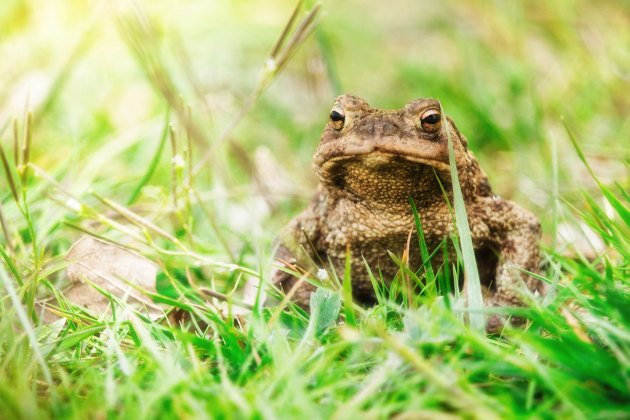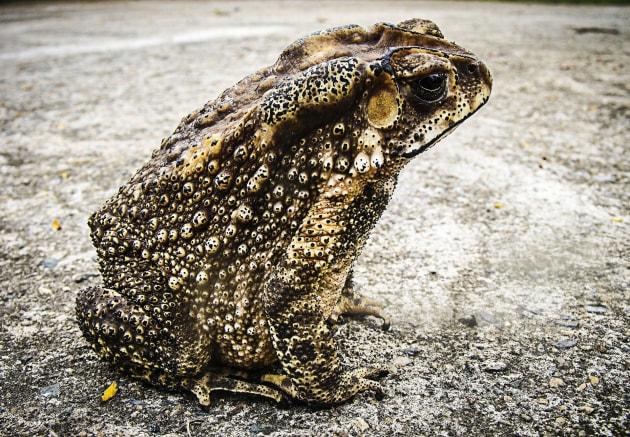


A common toad is a type of amphibian and is very similar to a frog. Due to this they quite often get mixed up. One of the key physical differences is that frogs are smooth and sleek, whereas toads have lots of lumps and bumps and can look wart-like. Frogs can also appear to look wet whilst toads have more dry leather looking skin.
Common toads tend to be larger than common frogs and have much shorter legs. Another difference is the toad generally crawls and walks, whereas frogs hop wherever they go.
A toad is part of the bufonidae family in which there are 580 different species. A common toad for example, which is found most commonly in the UK can vary in colour including olive-brown, green or grey. They grow up to 13 cm in length and female toads grow bigger than the males.
Did you know that when a toad is scared they use their warts located on their back to produce a vile tasting substance to defend them against predators, it’s also known as a poison gland?
|
Kingdom: |
Animalia |
|
Phylum: |
Chordata |
|
Class: |
Amphibian |
|
Order: |
Anura |
|
Family: |
Bufonidae |
|
Genus: |
Bufo |
|
Species: |
B. Bufo |

Yes, they are to their predators. The common toad has a poison gland and is used to scare away predators to show them that they don’t taste nice. Due to this if you ever handle a toad you should always wash your hands thoroughly to get rid of the toxins, although it’s not advised to handle a wild toad.
As toads are amphibians they have mucous glands in their skin and their skin has no feathers, scales or hairs.

A Common toad's habitat can be found throughout mainland Britain, except for the Scottish Islands, Northern Island, Isle of Man, the Isles of Scilly and most of the Channel Islands.
When choosing their habitat they go for shallow burrows in which they can safely return to after foraging for food or to hide away from predators. A toad's habitat is usually away from water, except for when they’re mating. Toads hibernate in the winter and adapt their habitat accordingly by choosing deep leaf littler, burrows and log piles.
The best place to see a toad would be in woodland areas, damp areas in gardens, parks, shrubby areas, fields, woods, lakes and slow-moving rivers. You’ll have more luck seeing toads during the months of March right through to October. You’re better looking for toads during the night as they are nocturnal. Listen out for low croaking around ponds during Springtime as this could be an indication that they’re very close!
Toads use the nighttime to forage for food as they are very active during this time. They eat a variety of invertebrates including spiders, slugs, worms, ants and aphids. Their tactic is to slowly sneak up behind them -- they use their tongue which is sticky to catch it.
Springtime marks mating season and during this time all toads migrate to the pond, so they can find a mate to reproduce with. Male toads would arrive first and wait for the female toads to appear. Once mating has finished females then release double strings of fertilised eggs among waterweeds. 10 days later a tadpole appears and the evolution begins.
Tadpoles mature at 16 weeks and start to gradually lose their tails and grow into their legs as they evolve into toads.
When it reaches the month of May toads leave the spawning pond as the mating season comes to an end.
Did you know that a female toad can produce up to 1,500 eggs?
One of a common toad’s threat is the loss of habitat, in particular, it’s the loss of their breeding ponds which is of most concern. Toads have started to lose their breeding ponds due to drainage of wet areas. Another threat to toads are roads, during the Springtime many toads are unfortunately run over as they migrate and make their journey to ponds for breeding.
However, conservation efforts are in place to allow toads to breed and hopefully keep their habitat. These measures include planting new trees and protecting a toad's habitat. You can also help by leaving a part of your garden to grow wild, it could be a small section, but it will really help create a natural habitat for toads.
Yes, in the UK toads are protected by law, but only for selling by trade. However, the common toad is a biodiversity priority under the Natural Environment and Rural Act (2006). This means that the toad should be considered whenever planning or making a new development to avoid further habitat loss.
In a few easy steps, you can help create the perfect habitat for a toad or a frog. This is a great way to help with their conservation and to help further protect and restore their habitat.
Firstly, you will need to find somewhere in your garden where you can dig a hole (it should be 30 - 45 cm deep). Once created you’ll need to collect logs and stones which will be buried in the hole to help create the perfect habitat. When creating the hole make sure you pick a place that provides plenty of shade.
You then need to create corridors to provide toads with plenty of room, think of it as like an underground maze for them. Create corridors that range from a few millimetres wide to a few centimetres to provide toads with protection and cover.
Then you need to continue to pile materials into the hole to build the pile into a low mound.
To finish off the hole put some builders ballast over the logs and rubble, then you need to cover it with soil on the top, however, you still need plenty of gaps and entrances to allow the toad to access the burrow.
To finish off you could add some branches to help with camouflage and some wildflower seeds at the top of the soil.
You can learn more about building a hibernation home for toads by downloading our Build a Hibernation Home for a Toad worksheet.
Here at Twinkl, we’re on hand to help support your teaching on all things related to toads and frogs, whether it’s helping them understand their habitat, what they eat, or how to tell the difference between the two, we have a resource for you. They’ve all been created by our range of experienced teachers, so you can rest assured that they’re all in line with national curriculum aims.
Using our resources is a great way to ease teacher workload, allowing you to spend more time on what matters the most - educating your class. They are also brilliant for home educators and parents too, to help you get the most out of your lesson, or perhaps as a great way to mix things up a little.
Click one of the links below for a great starting place to help explore the world of frogs and toads!
 Home
Home  Membership
Membership  Customer Support
Customer Support  Create
Create  Blog
Blog 




















